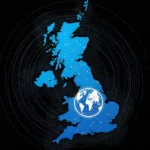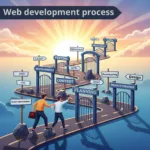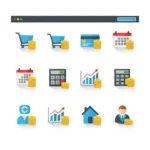- 1. Barnaby’s bright idea
- 2. Choosing the right social media platforms for theatres: A strategic selection
- 3. Social media content is King (or Queen!) for theatres: Engaging your audience
- 4. Talking with your audience, not at them: Building relationships
- 5. Measuring your social media success: Tracking progress for theatres
- 6. Barnaby’s buzzing theatre: A social media triumph
- 7. Further reading
Barnaby’s bright idea
Barnaby, the enthusiastic manager of the Thespian Theatre, Upper Bottomley, faced a challenge. The once-packed theatre was seeing fewer and fewer visitors. The velvet seats, usually filled with eager patrons, were starting to show a few too many empty spaces. “We need to try something new,” Barnaby declared, with a determined glint in his eye. “We need to dust off more than just the stage curtains! So, where did I put my manual on social media for theatres …?”
One afternoon, while browsing online (for “essential research,” he insisted, while sneaking a peek at cat videos), Barnaby had a lightbulb moment: social media! “It’s perfect!” he thought emphatically. “We can reach so many people, right in their pockets, and show them what they’re missing with a bit of online razzle-dazzle.” And with that, Barnaby’s social media journey began, filled with both excitement and a touch of trepidation.
Firstly, Barnaby needed to figure out was where to focus his energy. “Where does everyone spend their time online?” he wondered, scratching his head. “It’s not as simple as putting up a poster and hoping for the best, then?” This is a key question for any theatre looking to boost its social media presence. It’s not about being everywhere at once, but about being present where your target audience is most active.
Consider who you want to reach. Is your audience younger people, always on the cutting edge of what’s trending? If so, then they might be on platforms like Instagram or TikTok, where visual content reigns supreme and short, snappy videos are the order of the day. Conversely, are you trying to connect with an older crowd, who appreciate a bit more detail and community interaction? Facebook could be a better option for them, offering a space for discussions and event organisation.
It’s also worth thinking about what kind of content you want to share. If you have lots of visual content, like photos and videos of stunning sets, vibrant costumes, and captivating performances, Instagram is a great choice. If you want to share quick news and updates, behind-the-scenes snippets, and engage in real-time conversations, Twitter (or X) can be useful. And don’t forget Facebook – it’s still a powerful tool for building a community, promoting events, and sharing longer-form content that tells a story.
Barnaby, after much deliberation (and several cups of tea), decided to start with Facebook and Instagram. “A good social media foundation for all theatres,” he reasoned, “and we can always expand later.”
“What should we actually post?” Barnaby asked himself, staring at a blank social media calendar. “We can’t just put up show times and expect people to flock in.” This is where the fun begins! Social media is all about sharing engaging content that grabs people’s attention, sparks their curiosity, and makes them want to be part of the theatre’s world. Here are a few social media ideas tailored for theatres, for instance:
Behind-the-scenes glimpses
Give your audience a sneak peek at the magic that happens backstage. Share photos of rehearsals, where actors transform into characters and directors shape the performance. Show the intricate work of set building, where bare stages become fantastical worlds, or the delicate artistry of costume fittings, where fabrics and designs bring characters to life. People love to see the work, dedication, and passion that goes into putting on a show; it makes them feel more connected to the production.
Artist interviews
Chat with the actors, directors, playwrights, and designers involved in your productions. Ask them about their creative processes, their inspirations, and what audiences can expect from the show. What challenges did they face? What are they most excited about? These interviews add depth and personality to the production, giving audiences a richer understanding and a stronger connection to the artists.
Event highlights
Share photos and videos from past performances. Capture the excitement and energy of the theatre, the roar of the applause, the standing ovations. Create short video trailers that showcase the best moments of a show, giving potential audience members a taste of what they’re missing.
Audience participation
Run polls, quizzes, or Q&A sessions. Ask your followers what shows they’d like to see in the future, what their favourite theatrical moments are, or what they think of current productions. Get their opinions and feedback. This makes them feel valued and involved, turning them from passive observers into active participants in the theatre community.
Special offers and announcements
Also, use social media to promote ticket sales, discounts, or special events. Offer exclusive deals to your followers, like early bird discounts or behind-the-scenes tours. Announce new shows, cast members, or any exciting news about the theatre. Social media is not only a powerful tool for driving ticket sales but also keeping your audience informed and engaged.
Accordingly, Barnaby embraced his newfound creativity and started posting regularly. He shared photos of the stage being set for the new production and interviewed the lead actress (who had some hilarious stories about rehearsals and some insights into the lead actor). He even went further and created a poll asking people to vote for their favourite Shakespearean play.
Talking with your audience, not at them: Building relationships
Social media is a two-way street, a digital dialogue. It’s not just about broadcasting information from the stage to the seats; it’s about connecting with people on a personal level, creating a sense of community and belonging. Barnaby quickly learned that the most successful social media channels for theatres are the ones that interact with their followers; they build relationships and foster loyalty.
Always respond to comments and messages promptly and thoughtfully. Answer questions, address concerns, and thank people for their feedback. Ask questions and encourage discussion, creating a space for people to share their thoughts and opinions. Run contests or giveaways to get people involved, especially to spark excitement and encourage participation. The more you engage with your audience, the more valued and connected they’ll feel, and eventually, the more likely they’ll be to become loyal patrons of your theatre.
To this end, Barnaby made it a point to reply to every comment, even the cheeky ones. He started online discussions about the plays and even ran a contest where people could win tickets by submitting their own theatrical photos.
Barnaby was keen to know if his social media efforts were actually making a difference. “Are all these posts and replies translating into bums on seats, or just eyes on stalks?” he wondered. Luckily, most social media platforms provide analytics that can help you track your progress and measure the impact of your campaigns.
Look at key metrics like:
- Follower growth:
How many people are following your accounts? Are you gaining new followers consistently? This indicates the reach and appeal of your content. - Engagement rate:
How many people are liking, commenting, or sharing your posts? This shows how much your content resonates with your audience and sparks interaction. - Website traffic:
Is social media driving traffic to your theatre’s website? Are people clicking on links to buy tickets or learn more about shows? This demonstrates the effectiveness of social media in driving conversions. - Reach:
How many people are seeing your posts? This helps you understand the overall visibility of your social media efforts.
By monitoring these metrics, you can see what’s working and what’s not. You can then adjust your strategy, refine your content, and optimise your campaigns to improve your results and achieve your goals.
Barnaby diligently checked his analytics, noting which posts performed well and which ones flopped. He used this data to fine-tune his strategy, posting more of what his audience loved and less of what they ignored.
Eventually, thanks to his newfound social media skills and his willingness to embrace the digital age, Barnaby transformed the Thespian Theatre from a quiet venue to a bustling hub of activity. The social media feeds for the theatre were buzzing with excitement, filled with lively discussions, stunning visuals, and engaging content. People were clamouring for tickets to upcoming shows, eager to experience the magic of live theatre. Surprisingly, even to Barnaby, he even started using social media to get feedback from the audience, asking for their opinions on everything from the play selection to the theatre’s décor, which helped him make the theatre even better and more attuned to its patrons.
“Social media isn’t just about promoting events and selling tickets after all,” Barnaby realised, reflecting on his journey. “It’s about building a community, fostering a sense of belonging, and creating a genuine connection with our audience. It’s about opening up the stage door and inviting everyone in.” And that’s a powerful lesson every theatre can take to heart in today’s digital world.
Want to create your own social media success story and fill those seats? Check out these articles:
Further reading
Essential strategies for a theatre website: The ultimate guide to building a buzz





